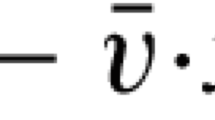Abstract
The alternating direction method solves large scale variational inequality problems with linear constraints via solving a series of small scale variational inequality problems with simple constraints. The algorithm is attractive if the subproblems can be solved efficiently and exactly. However, the subproblem is itself variational inequality problem, which is structurally also difficult to solve. In this paper, we develop a new decomposition algorithm, which, at each iteration, just solves a system of well-conditioned linear equations and performs a line search. We allow to solve the subproblem approximately and the accuracy criterion is the constructive one developed recently by Solodov and Svaiter. Under mild assumptions on the problem's data, the algorithm is proved to converge globally. Some preliminary computational results are also reported to illustrate the efficiency of the algorithm.
Similar content being viewed by others
References
Bertsekas, D.P. and Gafni, E.M. (1982), Projection method for variational inequalities with applications to the traffic assignment problem, Mathematical Programming Study 17, 139–159.
Bertsekas, D.P. and Tsitsiklis, J.N. (1989), Parallel Distributed Computation, Numerical Methods, Prentice-Hall, Englewood Cliffs, NJ.
Dafermos, S. (1980), Traffic equilibrium and variational inequalities, Transportation Science 14, 42–54.
Dennis, J.E. and Schnabel, R.B. (1983), Numerical Methods for unconstrained Optimization and Nonlinear Equations, Prentice-Hall, Englewood Cliffs, NJ.
Eaves, B.C. (1978), Computing stationary points, Mathematical Programming Study 7, 1–14.
Fletcher, R. (1985) Practical Methods of Optimization, Wiley, New York.
Fortin, M and Glowinski, R. (1983), Augmented Lagrangian Methods: Applications to the Solution of Boundary-Valued Problems, North-Holland, Amsterdam.
Gabay, D. (1983), Applications of the method of multipliers to variational inequalities. In: Fortin, M. and Glowinski R. (eds), Augmented Lagrangian Methods: Applications to the Solution of Boundary-Valued Problems, North-Holland, Amsterdam, 299–331.
Gabay, D. and Mercier, B. (1976), A dual algorithm for the solution of nonlinear variational problems via finite-element approximations, Computers and Mathematics with Applications 2(1), 17–40.
Glowinski, R. (1984), Numerical Methods for Nonlinear Variational Problems, Springer, New York.
Golub G. and Van Loan C. (1989), Matrix Computations, 2nd ed., Johns-Hopkins, Baltimore, MD.
Han, D.R. and Lo, H.K. (2002), A new alternating direction method for a class of nonlinear variational inequality problems, Journal of Optimization Theory and Applications 112, 549–560.
Han, D.R. and Lo, H.K. (2002), A new stepsize rule in He and Zhou's alternating direction method, Applied Mathematics Letters 15, 181–185.
Han, D.R. (2002), A modified alternating direction method for Variational Inequality Problems, Applied Mathematics and Optimization 45, 630–74.
Han, D.R. and He, B.S. (2001), A new accuracy criterion for approximate proximal point methods, Journal of Mathematical Analysis and Applications 263, 241–254.
Han, D.R. (2002), A proximal decomposition algorithm for variational inequality problems. Manuscript.
Harker, P.T. and Pang, P.S. (1990), Finite-dimensional variational inequality and complementarity problems: a survey of theory, algorithms and applications, Mathematical Programming 48, 161–220.
He, B.S. (1994), A new method for a class of linear variational inequalities, Mathematical Programming 66, 137–144.
He, B.S. (1994), Solving a class of linear projection equations, Numerische Mathematik 68, 71–80.
He, B.S. (1997), A class of new methods for monotone variational inequalities, Applied Mathematics and Optimization 35, 69–76.
He, B.S. (1999), Inexact implicit methods for monotone general variational inequalities, Mathematical Programming 86, 199–217.
He, B.S. and Zhou, J. (2000), A modified alternation direction method for convex minimization problems, Applied Mathematics Letters 13, 122–130.
Marcotte, P. and Dussault, J.P. (1987), A note on a globally convergent Newton method for solving variational inequalities, Operations Research Letters, 6, 35–42.
Nagurney, A. and Ramanujam, P. (1996), Transportation network policy modeling with goal targets and generalized penalty functions, Transportation Science 30, 3–13.
Rockafellar, R.T. (1976), Monotone operators and the proximal point algorithm, SIAM, Journal on Control and Optimization 14, 877–898.
Solodov, M.V. and Svaiter, B.F. (1999), A hybrid approximate extragradient-proximal point algorithm using the enlargement of a maximal monotone operator, Set Valued Analysis 7, 323–345.
Taji, K., Fukushima, M. and Ibaraki, T. (1993), A globally convergent Newton method for solving strongly monotone variational inequalities, Mathematical Programming 58, 369–383.
Wang, S.L., Yang, H. and He, B.S. (2000), Solving a class of asymmetric variational inequalities via a new alternating direction method, Computers and Mathematics with Applications 40, 927–937.
Author information
Authors and Affiliations
Rights and permissions
About this article
Cite this article
Han, D., Lo, H.K. Solving Variational Inequality Problems with Linear Constraints by a Proximal Decomposition Algorithm. Journal of Global Optimization 28, 97–113 (2004). https://doi.org/10.1023/B:JOGO.0000006717.61873.2c
Issue Date:
DOI: https://doi.org/10.1023/B:JOGO.0000006717.61873.2c




